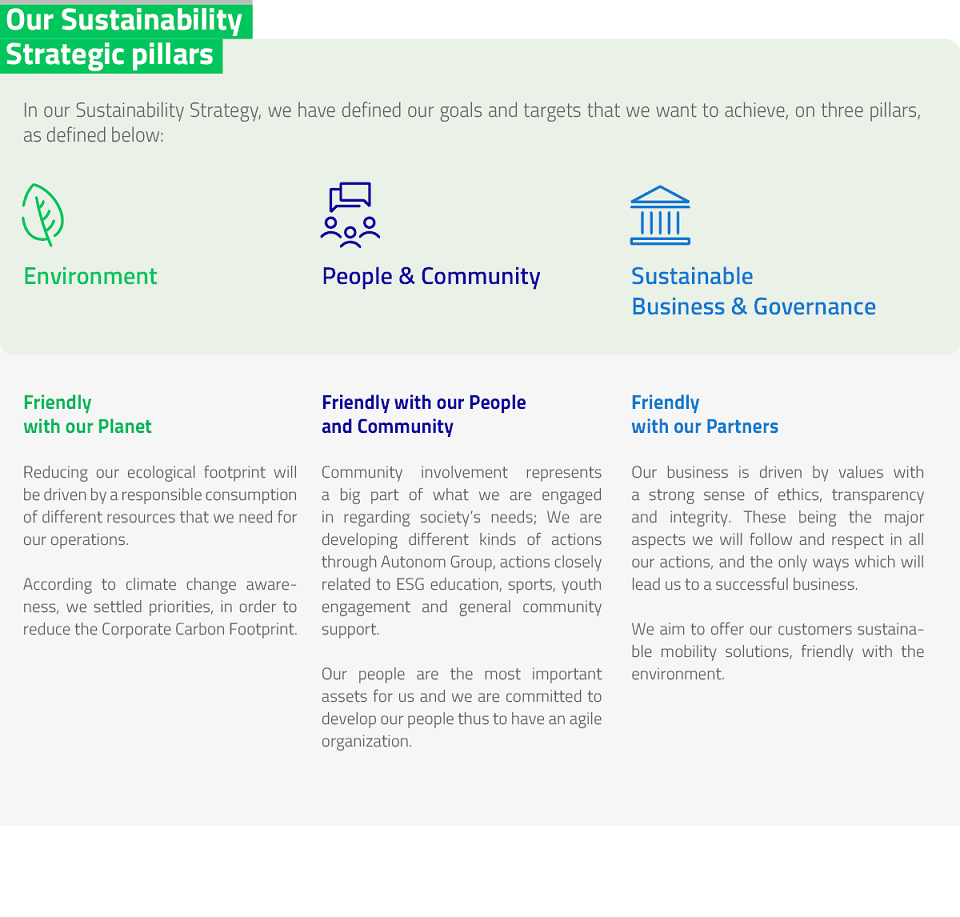2.1. Autonom’s Strategic Sustainability Directions
Autonom’s Sustainability Strategy is aligned with theorganisational culture performance matrix and environmental, social and governance (ESG) principles, while also aiming to comply with the most relevant EU strategies in the field.
It is built around three pillars: ‘Environment’, ‘People and Community’ and ‘Sustainable Business and Governance’, and the environmental one is an important direction for our future actions and decisions.

As main topics in the environment pillar, our focus is on the responsible consumption of the resources needed to carry out our activities and on reducing the negative impact caused using our operational fleet (operational leasing and rent-a-car), the emissions of which, although indirect for Autonom, represent 99% of the company’s total carbon footprint. As a result, our main priority is to reduce the average carbon emissions of the operational fleet by 25% by 2025 and by 51% by 2030, especially by increasing the share of green vehicles in the operational fleet.
The second important direction for us is people and community. Since the company’s inception, we have aimed to create an environment where people thrive every day and can contribute to positive change in the communities we serve, by supporting education and reducing our impact on the environment. The target set was to allocate a minimum of 2% of net profit to support educational projects. As far as the development of our people is concerned, we have always believed that their success breeds the success of the company and therefore we have set ourselves the target of supporting their development with a minimum of 50 hours of training per year per employee.
Last, but not least, because we want to build a sustainable future together with our partners, we have set as clear actions the involvement of all categories of stakeholders in joint projects around sustainability, customer satisfaction (measured by NPS) and increasing the number of digitised processes.
Autonom’s Sustainability Strategy is available in full on our website, Sustainability section (www.autonom. com/sustainability)
Strategic Sustainability Pillars | KPI definition | Reference year 2020 | 2021 | 2022 | 2023 | 2025 | 2030 |
|---|---|---|---|---|---|---|---|
Objectives/Targets | |||||||
Environment | |||||||
ENV | Average WLTP gCO2/km of the operational fleet | 153.57 | 144.51 | 136.48 | 130.26 | 115.13 | 75.87 |
ENV | Tonnes of wastepaper/year | 3.53 | 2.28 | 2.02 | 1.77 | 1.27 | 0 |
ENV | Tonnes of waste oil recycled/year | 0 | 10 | 15 | 20 | 30 | 50 |
Tonnes of tyre waste recycled/year | 0 | 10 | 15 | 20 | 30 | 50 | |
People and community | |||||||
CSP | % Total euro of net profit | 15 | ≥2 | ≥2 | ≥2 | ≥2 | ≥2 |
PEC | Number of training hours/ FTE | 38.6 | ≥50 | ≥50 | ≥50 | ≥50 | ≥50 |
Sustainable business and governance | |||||||
SBG | Net promoter score | 82 | ≥80 | ≥80 | ≥80 | 85 | 85 |
SBG | Number of processes/organisations digitised | 3 | 4 | 5 | 6 | 6 | 10 |
SBG | Top 5 in our industry RO | Top 5 | - | ** | - | ** | ** |
Legend:
Green colour = goal achieved
Red colour = untouched target
** = Market research
Data on our performance aligned with our strategic plan can be found in each specific chapter, which addresses progress towards our targets by specific pillars.
